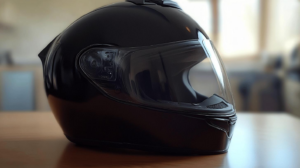Is your helmet chin placement truly safe? The position of your chin inside your helmet can be more critical than many riders realize.
A perfectly positioned helmet doesn’t just sit well—it provides crucial protection by ensuring stability and comfort for those long rides. This article deep-dives into the essentials of chin placement, highlighting its significance in motorcycle helmet fit and safety.
Delve into potential pitfalls of incorrect placement and discover how correct positioning can vastly improve your riding experience, helping you ride safer and with more confidence.
Importance of Proper Chin Placement in a Motorcycle Helmet

In motorcycle helmet fit, the chin plays a pivotal role in ensuring both safety and comfort. Proper chin placement means the chin should be snug against the chin strap without excessive tightness, allowing for comfortable movement and speech.
This position not only secures the helmet but also prevents it from moving excessively during a ride, which is essential for maintaining balance and control on the road. A helmet that sits firmly on the head, with an appropriately tightened chin strap, minimizes the risk of helmet displacement during sudden movements or impacts.
Incorrect chin placement poses significant risks, compromising helmet safety. If the chin strap is too loose, the helmet can shift or even detach during a crash, providing inadequate head protection.
Conversely, a strap that is too tight can cause discomfort, leading to pressure points and potential headaches over time. This discomfort might distract a rider, increasing the risk of accidents. Moreover, improper chin placement can restrict airflow, impacting breathing comfort, especially on longer rides.
In contrast, correct chin placement enhances the protective capabilities of a helmet, ensuring that it absorbs and distributes impact forces effectively. This alignment reduces the likelihood of severe injury in the event of an accident. Additionally, it offers increased comfort by preventing pressure points and allowing for natural jaw movement.
Riders experience reduced fatigue during long rides, as the helmet remains stable and comfortable, making the overall riding experience more enjoyable and secure. Proper chin placement is a crucial aspect of helmet safety, contributing significantly to both protection and ride quality.
How to Check Your Helmet's Chin Fit

A snug fit helmet is paramount for rider safety, particularly regarding the chin strap adjustment. Ensuring your helmet fits correctly involves a few crucial steps that can prevent excessive movement and discomfort.
A checklist can be an effective tool to verify that your helmet's fit is optimal. By systematically following these steps, riders can confirm their helmet provides the necessary protection and comfort during every ride.
- Secure the Chin Strap
Fasten the chin strap so it rests snugly against the jaw but not so tight that it restricts movement or causes discomfort. The strap should allow you to speak comfortably without feeling constricted.
- Check for Excessive Movement
Shake your head gently from side to side and nod up and down. The helmet should remain stable, and the strap should prevent any significant shifting. If the helmet moves, the chin strap needs further adjustment.
- Perform the Roll-Off Test
Attempt to roll the helmet off your head by pushing from the back. A well-fitted helmet should stay in place. If it slides off easily, the fit is too loose, indicating that adjustments or a different size may be necessary.
- Evaluate Pressure Points
Ensure there is no excessive pressure on the chin or jaw area. Any discomfort here can lead to irritation or headaches during long rides, compromising your focus and enjoyment.
- Inspect Strap Condition
Regularly check the chin strap for signs of wear or damage. A compromised strap can affect the helmet's stability, making it crucial to replace damaged components promptly.
Consistent helmet checks are vital for maintaining safety and comfort. Over time, straps can loosen, and head shape or size may change slightly, affecting fit. Regular adjustments ensure your helmet continues to protect effectively. By adhering to these steps and routinely evaluating your helmet's fit, riders maintain both safety and comfort, enhancing their riding experience.
Common Mistakes in Motorcycle Helmet Chin Placement

Incorrect chin placement is a frequent issue among riders, often stemming from common helmet fit myths and misconceptions. These errors can lead to discomfort and compromise safety. Understanding where your chin should be in a motorcycle helmet is crucial for avoiding helmet wobble and ensuring a secure fit.
-
Choosing a helmet based on brand or style, neglecting the correct size and fit.
-
Fastening the chin strap too loosely, causing the helmet to shift or move excessively.
-
Over-tightening the chin strap, leading to uncomfortable pressure points on the jaw.
-
Ignoring helmet wobble when nodding or shaking the head, which indicates a poor fit.
-
Failing to replace worn or damaged chin straps, affecting helmet stability.
To address these issues, start by selecting a helmet that matches your head shape and size, rather than focusing solely on aesthetic appeal. Ensure the chin strap is adjusted to hold the helmet firmly in place without causing discomfort.
Regularly inspect the strap for wear and replace it as needed to maintain a secure fit. If the helmet wobbles or shifts, consider adding extra padding or trying a smaller size.
By making these adjustments, riders can enhance both comfort and safety, reducing the risk of accidents and improving the overall riding experience.
Choosing the Right Helmet for Optimal Chin Placement

Selecting the right motorcycle helmet is crucial for achieving optimal chin placement, which enhances both safety and comfort. The fit of a helmet is significantly influenced by its size and the shape of the rider's head.
To determine the correct size, measure the circumference of your head around the crown. Equally important is identifying your head shape—whether it's round, intermediate oval, or elongated oval—as different helmets cater to various shapes.
Properly matching the helmet to your head shape ensures that the chin strap aligns correctly, offering a secure fit without excessive pressure or movement.
Matching Helmet Types and Head Shapes
Understanding the correlation between helmet types and head shapes is vital for ensuring a comfortable and safe ride. Each helmet type is designed to accommodate specific head shapes, providing the best fit and chin placement.
-
Full-Face Helmets: Best suited for intermediate oval head shapes, offering comprehensive coverage and protection.
-
Open-Face Helmets: Typically designed for round head shapes, providing good visibility but less protection for the chin area.
-
Modular Helmets: Ideal for elongated oval head shapes, combining the protection of full-face with the convenience of open-face designs.
- Half Helmets: Generally fit a variety of head shapes, though they offer minimal protection and are less secure for chin placement.
Choosing a helmet that matches your head shape not only improves the fit but also ensures that the chin strap sits correctly, enhancing overall helmet stability. A well-fitted helmet reduces the risk of pressure points and discomfort, allowing riders to focus on the road without distractions.
By considering head shape and helmet type, riders can achieve better chin placement and enjoy a more comfortable riding experience.
Expert Tips for Maintaining Your Helmet's Chin Placement

Maintaining proper chin placement in a motorcycle helmet is crucial for both safety and comfort. Regular helmet maintenance plays a significant role in ensuring that the chin strap remains effective. Over time, wear and tear can compromise a helmet's integrity, leading to a poor fit.
Routine checks and cleaning with mild soap and water help preserve the helmet's condition and functionality. Additionally, it's important to recheck your helmet's fit annually.
Padding can compress, and head size can change slightly over time, affecting how the helmet sits on your head. By keeping up with maintenance, riders can prevent issues that might lead to discomfort or a compromised fit.
- Inspect for Wear and Damage
Regularly examine the helmet for any signs of wear or damage, especially around the chin strap and fasteners.
- Clean with Mild Soap
Use mild soap and water to clean your helmet, avoiding harsh chemicals that could degrade materials.
- Recheck Fit Annually
Evaluate the fit of your helmet each year, as padding compression can alter its snugness.
Proper maintenance of your motorcycle helmet ensures it continues to provide the necessary protection and comfort. By keeping fasteners secure and regularly inspecting the helmet, riders can reduce the risk of accidents caused by poor fit.
Well-maintained helmets not only enhance safety by providing consistent performance but also contribute to a more enjoyable riding experience by minimizing discomfort and distractions.
Final Words
Mastering helmet fit starts with understanding where should your chin be in a motorcycle helmet. Proper chin placement offers pivotal protection and comfort. Missteps in fit can compromise safety.
Riders should regularly verify that helmets are snug and straps appropriately adjusted. Choices in helmet size and shape significantly impact fit, so careful selection matters.
By maintaining proper chin fit, riders enjoy enhanced safety and long-lasting ride comfort. Stay vigilant, ride safely, and embrace every journey with confidence.
FAQ
Q: Should my motorcycle helmet touch my chin?
A: A motorcycle helmet should be snug, with the chin strap fitting firmly without pressing hard against your chin, allowing for comfortable speech without feeling restricted.
Q: How should a helmet fit a motorcycle?
A: The helmet should fit snugly on your head, without excessive movement when shaken. The chin strap must be secure, the helmet shouldn't press on the neck or forehead, and vision shouldn't be blocked.
Q: How to wear a motorcycle helmet?
A: Wear a motorcycle helmet by pulling the straps over your head, positioning it firmly so your ears align with the openings, securing the chin strap, and adjusting for a snug, comfortable fit.
Q: Should a helmet cover the chin?
A: A helmet doesn't need to cover the chin but should protect it adequately. Helmets generally feature chin bars or guards for enhanced protection in certain regions, like full-face helmets.
Q: How to put on a motorcycle helmet strap?
A: Guide the chin strap beneath your chin and through the D-rings if available. Pull until snug, then secure the excess strap with its clip or fastener to maintain proper tension.
Q: What is the 2 2 2 rule when fitting a helmet on your head?
A: The 2-2-2 rule suggests two fingers' space above the eyebrows, two fingers fitting beneath the chin strap, and two fingers space between the edge of the helmet and the nose.
Q: How tight should a motorcycle helmet chin strap be?
A: A chin strap should be tight enough to secure the helmet, fitting two fingers underneath comfortably. It should not cause discomfort or press excessively on the jaw or neck.
Q: How to stretch a motorcycle helmet?
A: Stretch a helmet cautiously using specialized helmet stretchers or gradually through regular use, allowing the padding to conform to your head shape. Avoid forced stretching that can damage the helmet.
Q: What is a motorcycle helmet nose guard?
A: A nose guard in a motorcycle helmet, often a part of the visor or chin guard, deflects wind and reduces fogging by directing breath away from the face shield.

Mark Anderson is a trusted expert with over 25 years of riding experience. At 56, his deep knowledge of long-distance touring and participation in major motorcycle rallies makes him a reliable source for gear recommendations on ProtectiveGearz. Mark’s decades of firsthand experience ensure his advice is authoritative and valuable to riders seeking expert guidance.



